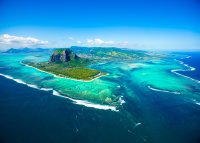The city On the other side of the main road from the harbour is the city. Facing the Place S Bissoondoyal, Government House is at the far end of the old parade ground, announced by an avenue of palms. The name was officially changed from Place d’Armes to honour a Mauritian politician and independence leader but many locals still refer to it by its old name. The roads at each side of the lawns are Duke of Edinburgh Avenue (on the left, facing Government House) and Queen Elizabeth Avenue (on the right). The old thoroughfares of Royal Street and Chaussée meet in front of Government House. The Chaussée, originally a causeway of rough stones constructed over a swamp, was rebuilt in 1779 by a French engineer. The trickle that remains of Pouce Stream runs down a concrete gully under the small Chaussée Bridge.
A statue of a matronly Queen Victoria stands at the entrance to Government House, with a statue of a nearly forgotten man, Sir William Stevenson (governor 1857–63), in the forecourt behind her. He claimed the same privileges for Mauritian officials that British ones enjoyed. Nearby is a statue of Sir John Pope Hennessy, the most outstanding governor of the latter part of the 19th century (1883–89), sympathetic to calls of Mauritius for Mauritians.
Government House dates back to 1738 when Labourdonnais built the ground floor and the wings that form the forecourt’s sides from stone. In General Decaen’s time, wooden upper storeys were added, just before the British arrived in 1810. Although no longer the home of the governor, the building is at the centre of government since, together with the office block adjoining it and the Legislative Assembly Chamber behind it (built in 1965), it is part of the parliamentary complex.
Nearby Chaussée Street has shops and offices on one side, and the Company Gardens and the Mauritius Institute building on the other. The rather grand, sandy coloured building was constructed between 1880 and 1884; it now houses the Mauritius Museums Council and the Natural History Museum on its ground floor is well worth a visit. The Company Gardens derives its name from its connection with the French East India Company in the 18th century, when it was created from the marshland around the Pouce Stream. For ten years after the fire of 1816, which destroyed half of Port Louis, it was the site of the town market. Although it is less than a hectare in area, the garden seems larger, with its narrow paths, flower beds, shrubs and ponds. There are numerous statues, some of which are national monuments, including one of Adrien d’Epinay, planter, lawyer and campaigner against the abolition of slavery, and Léoville l’Homme, poet. The importance of the garden as the city becomes more built-up is evident and at lunchtimes you will see locals enjoying the shade of the impressive banyan trees. At night, the gardens attract a rather seedier element and are best avoided.
The Municipal Theatre on Jules Koenig Street has been restored to look like another Victorian warehouse but with its colonnaded front a sharp contrast to the mediocre buildings around it. It was opened in 1822 with a production by a Creole amateur troupe of La Partie de Chasse de Henri IV and is said to be the oldest theatre in the southern hemisphere.
The days of its popularity as an opera house have passed and it is now only by chance that you’ll be able to see inside since it is invariably closed and shuttered. The occasional productions that the theatre puts on today are mostly amateur Creole musicals, depending on the rhythms of local séga music to emphasise stories of liberation – quite a contrast to the European operas of its heyday.
Opposite the theatre, Old Council Street (Vieux Conseil Street) is an attractive cobbled lane lined with shops and eateries. The Souk du Vieux Conseil has modern boutiques and a food court; it is a welcome retreat from the hectic city centre and a good spot for lunch.
City Hall, built in 1962, is a few yards away on Jules Koenig Street. Outside is a concrete block tower without walls, with steps spiralling up its interior to the clock at the top. This represents the fire towers formerly used by watchmen to overlook the town’s wooden buildings. There is a library in City Hall.
Beyond City Hall on the right-hand side is a police station and the Supreme Court (a listed building), with the Cathedral Square on the left. Now a garden, the square contains the remains of a fountain dating to 1788, an obelisk, and what appears to be a statue of medieval King Louis IX of France, also known as St Louis, erected in 1896.
The Roman Catholic St Louis Cathedral is the third church on this site. Built in 1932 in awesome twin-towered imitation Gothic, it replaced the previous one, demolished in 1925. An earlier church on the site dating from 1756 was destroyed by a cyclone. Within is the tomb of the wife of Mahé de Labourdonnais. The Episcopal Palace, a 19th-century mansion with airy verandas more suited in style to the tropics than the cathedral, stands behind it.
The Anglican St James Cathedral has its entrance on Poudrière Street. As a cathedral this is a disappointment, since it looks more like a small New England mission church with its single, cream-plastered spire. It was built in 1828, incorporating the 2m-wide walls of the original building, a French powder magazine. Its stoutness made it a useful cyclone shelter in the last century. Inside it has a wooden ceiling and wood-panelled walls with commemorative tablets set in them. Services in English are held on the second and fourth Sunday every month; except during times of worship, the cathedral is closed.
There are some small wooden mansions from the French period in the block between Poudrière Street and St George Street. There are also a large number of embassies and high commissions in the area. (For details see Chapter 3, Embassies and consulates, page 49).
At the end of Pope Hennessy Street is the Champ de Mars Racecourse. People still promenade here as they did in the 19th century, although joggers and children have taken the place of crinolined ladies and their beaux. There is a statue of King Edward VII in the centre and the tomb of Malartic (governor 1792–1800) at the far end. This is a striking setting for racing with a backdrop of gaunt mountains like a natural amphitheatre for the drama played out on the plain. (See also pages 87 and 105.)
The Champ de Mars has been a racecourse since the Mauritius Turf Club was founded by an English army officer, Colonel Edward Draper, in 1812, making it the oldest racecourse in the southern hemisphere and one of the oldest in the world. Draper oversaw the building of the track on what was then the army parade ground. At first, only horses belonging to the English garrison were ridden by young army officers, until the French settlers showed interest and entered their own horses. By 1837, horse racing was firmly established. Today the Mauritians’ love of gambling ensures that races are always well attended.
On the north side of the Champ de Mars, at the corner of Dr Eugene Laurent and Corneille streets, is the Lam Soon Temple (( 06.00–14.00 daily), which is actually two temples. The newer one, built in the 19th century, is in the foreground, a curious adaptation of British colonial architecture to Buddhist needs, the columns of the veranda painted red and gold and the interior devoted to worship. The centre altar is extravagantly carved while the interior walls are simple.
The ancient custodian makes a point of telling visitors the temple is independently run and depends on offerings for its upkeep, indicating the offertory box. Once you’ve put something in, you’re invited to walk through to the more dilapidated wooden temple beyond. This temple doubles as a commercial enterprise, selling not only incense sticks and flags but also soft drinks and pickles. Business, according to the old custodian, is brisk on race days.
The Shree Vishnu Kchetra Temple is in a tranquil location in St Denis Street, parallel to the Champ de Mars, one block away. It serves Hindus and Tamils. The older Hindu temple is simply laid out with bright paintings and statues and places for offerings of coconuts and incense. Worshippers toll the bell to wake the gods.
In the same compound is a new Tamil temple and an ancient, sacred peepul tree (Ficus religiosa, known as a ‘bo-tree’ in Sri Lanka). The temple is closed for five minutes at midnight when it is considered a dangerous time to disturb the gods.
The Jummah Mosque, with its ‘wedding cake’ architecture, is, unsurprisingly, on Jummah Mosque Street. The mosque extends an entire block, its white towers and friezes imposing grace on the clutter of lock-up shops beneath its balconies. Its huge teak doors are priceless, ornately carved and inlaid with ivory. The muezzin’s call from the minaret before dawn is the signal not only for prayer but for the cacophony of the city to erupt. This mosque, built in the 1850s and extended over the years, is the island’s most impressive and opened when Muslims formed an exclusive merchant group in the neighbourhood. A group of Muslim merchants banded together and bought two properties and built the mosque on the site. Visitors can enter the inner courtyard outside prayer times. In the courtyard is an old badamia tree, older than the mosque itself.
Near the mosque in Royal Street is Chinatown, a clutter of stores, warehouses and restaurants, its shops bright with the plastic and chrome knick-knacks much in demand by modern-day Mauritians. The location of Chinatown so near to the mosque has caused some tension between the two communities, which at its height resulted in the burning down of the Chinese-run Amicale Casino.
Between Farquhar and Queen streets is Port Louis market, selling fruit and vegetables, meat, fish, clothing and handicrafts. The wrought-iron work above the entrance has the initials VR (Victoria Regina) intertwined in it. In 2004, the market buildings were completely renovated. As a result, the market lost some of its grubby charm and a greater proportion of it (mostly the first floor) was taken over by souvenir stalls. It may not feel as ‘authentic’ as it once did but it is still an exciting, bustling place, which offers an insight into the everyday lives of Mauritians. (See also, Shopping, page 110.)
At the southern end of the city, along Jemmapes Street from the Victoria Square bus station are the Line Barracks, whose foundations go back to the early days of the French occupation, when they housed 6,000 men, as well as rebel colonists after the French Revolution. A police station, the police headquarters and the traffic branch are there now.
Signal Mountain between Plaine Lauzon and the city marks the western end of the mountain range around Port Louis. A beacon used to be kept alight on its summit at night, and flags hoisted there during the day as a guide for approaching vessels. At the foot of the mountain is the Marie Reine de la Paix monument and its pleasant gardens, where the first Mauritian bishop was consecrated in 1989. The Edward VII Boulevard provides a spectacular view of the city and harbour.
Sainte-Croix, a suburb of Port Louis nestling below Long Mountain, is famous for its church, a modern-style replacement of the original, with its shrine containing the body of Père Laval














